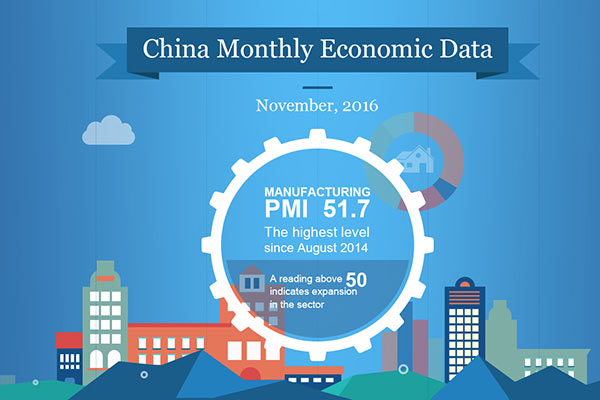Growth strong, to support reforms this year
 |
|
The first Peugeot 4008 car was first produced at Dongfeng Peugeot Citroen Automobile Company's Chengdu plant. [Photo by Zhou Yaqing/For China Daily] |
China's factories and services both closed out 2016 on relatively robust notes that signal growth is strong enough for policymakers to keep pushing for economic reforms this year.
The manufacturing Purchasing Managers Index stabilized near a post-2012 high in December, edging down to 51.4 from 51.7 the prior month.
The non-manufacturing PMI slipped to 54.5 from a two-year high of 54.7 in November.
Numbers higher than 50 indicate improving conditions. A gauge of factory input prices surged to a five-year high of 69.6.
"Clearly activity levels firmed heading into year-end," said Geoffrey Yu, head of the UK investment office at UBS Wealth Management in London. "Stabilization isn't too much of an issue right now, compared to the micro-level problems such as liquidity, regulation, and, of course, the exchange rate."
The readings capped a year of strengthening across a range of indicators and continued a reversal from the dark outlook in February, when the manufacturing gauge tumbled to 49.
The economy is on pace to meet the official growth target, posting 6.7 percent expansions in the first three quarters of 2016, while factory prices have snapped four years of deflation.
The private manufacturing PMI by Caixin Media and Markit Economics confirmed the strength in official data. The gauge advanced to 51.9 in December, the highest since January 2013, data showed Tuesday, exceeding the 50.9 estimate in a Bloomberg survey of economists.
That's good news for policymakers as they shift to neutral monetary policy and seek to defend against a trio of threats: a potential pickup in capital outflows after the yuan posted its steepest annual slump in more than two decades; Federal Reserve interest rate rises; and US President-elect Donald Trump, who has called for punitive tariffs on China's exports.
Outflow pressure may resume after a Jan 1 reset of the country's $50,000 cap on how much foreign currency individuals are allowed to convert each year. An estimated $689 billion flowed out of China in the first 10 months of 2016, a Bloomberg Intelligence gauge shows.
China's foreign reserves, the world's largest stockpile, fell to a five-year low of $3.05 trillion as of November.
China's central bank said on Dec 30 that it tightened requirements for lenders to report cross-border transactions by customers as part of stepped-up efforts to curb money laundering.
Ma Jun, chief economist of the People's Bank of China research bureau, said the requirement "is not capital control at all," the Xinhua News Agency reported on Jan 1.
Outflows aside, the economy proved bears wrong last year. Growth picked up to about 7 percent in November, a monthly tracker from Bloomberg Intelligence showed. Economists have been raising their estimates for 2016 and 2017 growth, Bloomberg surveys showed.
The manufacturing report showed improving market demand and robust consumption before the new year, the National Bureau of Statistics said on Jan 1 in a supplementary statement. The cost of raw materials and logistics is the highest in recent years and is certain to impact business operations as rising corporate costs are squeezing profits, the NBS said.
"PMI indicated continued strength in the industrial cycle," China International Capital Corp economist Eva Yi wrote in a report. "Demand growth started to firm up in sectors that cater toward manufacturing investments and personal consumption. We expect further broadening of the reflationary impulse from the upstream heavy industrial sectors to mid-to-downstream manufacturing industries."
Beyond the main PMI, other early gauges also signal the economy closed out the year on a firmer footing last month. Large and small firms reported stronger momentum and the mood among executives was the brightest in two years.
Bloomberg

















